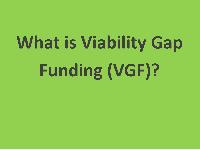
The main constraint in India’s infrastructure sector is the lack of source for finance. More than the overall difficulty of securing funds, some projects may not be financially viable though they are economically justified and necessary. This is the nature of several infrastructural projects which are long term and development oriented.
For the successful completion of such projects, the government has designed Viability Gap Funding (VGF). Viability Gap Finance means a grant to support projects that are economically justified but not financially viable.
Viability Gap Funding is provision of a grant one-time or deferred, under a scheme
with the objective of making a project commercially viable. There will be a viability gap between the cost of the project and the cash flow or mnetary retrun from it. Though the explicit monetary return from it may be lower than the cost incurred, the project may be giving more benefits to the socieity. Hence, for compensating the low monetary return to the project implementing agency, the government is providing a grant from the budget to compensate or to fill the viability gap.
The scheme is designed as a Plan Scheme to be administered by the Ministry of Finance and amount in the budget are made on a year-to- year basis.
Such a grant under VGF is provided as a capital subsidy to attract the private sector players to participate in PPP projects that are otherwise financially unviable. Projects may not be commercially viable because of long gestation period and small revenue flows in future.
The VGF scheme was launched in 2004 to support projects that comes under Public Private Partnerships. Under the budget 2022, Rs 500 crore has been allocated for infrastrcuture projects.
VGF grants will be available only for infrastructure projects where private sector sponsors are selected through a process of competitive bidding. The VGF grant will be disbursed at the construction stage itself but only after the private sector developer makes the equity contribution required for the project.
The usual grant amount is upto 20% of the total capital cost of the project. Funds for VGF will be provided from the government’s budgetary allocation. Sometimes it is also provided by the statutory authority who owns the project asset. If the sponsoring Ministry/State Government/ statutory entity aims to provide assistance over and above the stipulated amount under VGF, it will be restricted to a further 20% of the total project cost.
The project agreements must also follow the best practices that would secure value for public money. Regular monitoring and evaluation should be done by the lead financial institutions for the disbursal of the grants.
The lead financial institution for the project is responsible for regular monitoring and periodic evaluation of project compliance with agreed milestones and performance levels, particularly for the purpose of grant disbursement.
*********









